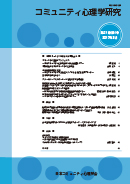Volume 14, Issue 2
Displaying 1-6 of 6 articles from this issue
- |<
- <
- 1
- >
- >|
Lecture
-
2011Volume 14Issue 2 Pages 105-114
Published: March 31, 2011
Released on J-STAGE: October 17, 2020
Download PDF (897K)
Original Articles
-
2011Volume 14Issue 2 Pages 115-131
Published: March 31, 2011
Released on J-STAGE: October 17, 2020
Download PDF (1449K) -
2011Volume 14Issue 2 Pages 132-150
Published: March 31, 2011
Released on J-STAGE: October 17, 2020
Download PDF (1708K) -
2011Volume 14Issue 2 Pages 151-165
Published: March 31, 2011
Released on J-STAGE: October 17, 2020
Download PDF (1619K) -
2011Volume 14Issue 2 Pages 166-189
Published: March 31, 2011
Released on J-STAGE: October 17, 2020
Download PDF (2227K)
Book Review
-
2011Volume 14Issue 2 Pages 190-193
Published: March 31, 2011
Released on J-STAGE: October 17, 2020
Download PDF (332K)
- |<
- <
- 1
- >
- >|
